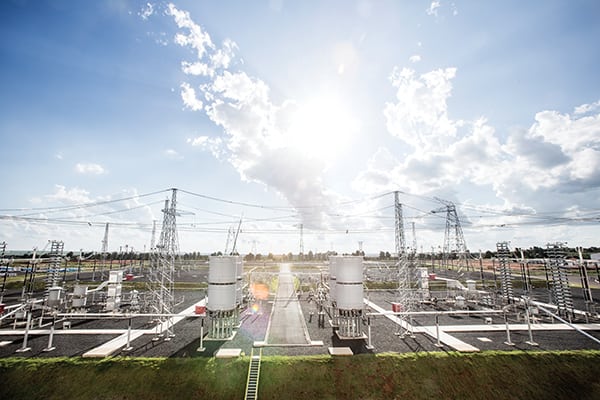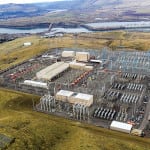A 7,100-MW±600-kV high-voltage direct-current (HVDC) line that runs 2,375 kilometers (km) from new hydropower plants on the Madeira River in the Amazon Basin to major load centers in southeastern Brazil became the world’s longest transmission line this August.
The Rio Madeira HVDC system was built by Swiss power and automation technology group ABB for a consortium comprising Spain’s Abengoa Group and Brazil’s Abengoa Construção Brasil. It consists of two 3,150-MW HVDC converter stations placed at either end of the line: at hydropower plants at Porto Velho in northwest Brazil and in the southeast near São Paulo (Figure 2). ABB also delivered an 800-MW HVDC “back-to-back” station that transmits power to the alternating current (AC) network in the northwest of Brazil.
The Rio Madeira project, built as part of the Brazilian government’s Program to Accelerate Development, is a big step for the country whose power system is about 75% hydroelectric.
The line is the country’s second 600-kV HVDC transmission system. In the mid-1980s, ABB completed the first HVDC project (with a total rated power of 6,300 MW) to deliver power from the 12-GW Itaipu hydroelectric power plant. That 1,590-km project was for more than two decades the longest and most powerful HVDC transmission link in the world. But in 2010, that title was usurped by the 6,400-MW±800-kV Xiangjiaba-Shanghai ultra-HVDC transmission system, a 2,071-km line that connects the Xianjiaba Dam to Shanghai in China. Another notable project in the works is Siemens’ 2,200-MW submarine HVDC link to connect Scotland and England at 600 kV.
Companies developing HVDC transmission technologies tout its prime benefit of reducing transmission losses by 30% to 50% compared to alternating-current overhead lines. For lengths of about 600 km or more, consensus is that overhead lines using HVDC transmission technology are more cost-effective than AC technology.
According to Siemens, the current €2.5-billion-per-year HVDC market will double within the next five years. Demand for HVDC transmission is “increasing rapidly,” says the company that is a major competitor in the market along with ABB and Alstom. In the last 40 years, HVDC transmission links with a total capacity of 100 GW were installed, and another 250 GW may be added this decade alone, Siemens projects. Drivers for this massive growth include connecting offshore wind farms to the grid (such as in Germany, where wind projects are far offshore), transnational grid connections, and remote load area connections. “Back-to-back” HVDC links, which connect two AC grids and serve as a “firewall” to prevent faults from passing into the neighboring grid, will also spur growth. And growth will be particularly strong in countries with surging energy demand and large distances to cover, specifically China, India, and Brazil.
Even so, Siemens notes: “The power transmission market is basically volatile, since it is influenced by large-scale projects.”
—Sonal Patel is a POWER associate editor (@POWERmagazine, @sonalcpatel)










